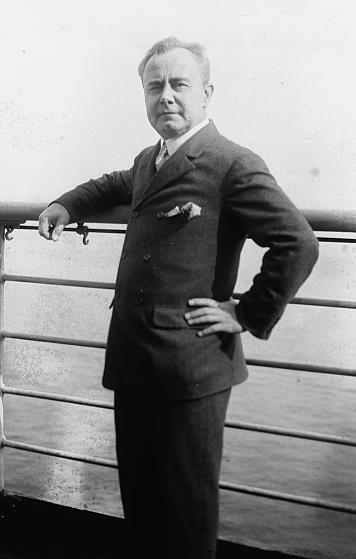Joseph Hofman
Life experience
In the early years of Mr. Hoffmann Munich, Germany, studied architecture design, put into Wagner sects. In 1895, Hoffman traveled to Italy to do when art students generally aspire to "pilgrimage trip," Wagner returned to Vienna after entering the design firm.
1897 years Hoffman joined the famous design thinking in a very "avant-garde" and "Vienna Secession" and the following year to participate in "Secession," the first exhibition and designed them The main exhibition hall.
1899 years Hoffman and several classmates as he and Bridgewater Orr Meusel, who together regularly organized "academic Salon", the same year Hoffmann was appointed to the Vienna Academy of Fine Arts professor of architectural design. In 1905, Hoffman made "people's guiding principle is functional, practical people the first condition, it must focus on the proper use of appropriate proportions and materials. People should seek only to decorate in time to be decorated, and not at all costs to decorate. "

1914, he participated in the Cologne organized by the" Deutsche Werkbund exhibition. " In 1925, he took part in the Paris Exhibition of Art and Design.
1930 he participated in the World Expo held in Stockholm.
1941 years retired from the Vienna Academy of Fine Arts.
While engaged in forty years of teaching, he undertook a number of important architectural projects. Special forces such as Te Duoke Palace (1905-1924), the 普克斯多特 sanatorium (1904-1905 years) as well as the famous "chair" for which he designed the nursing home (suitable for sitting machine).
After the First World War, Hoffman turned to neo-classical design or new rococo style, he later turned eclecticism became a complicated decorative illustration from the early simple style. His decorative works of the 1920s were dismissed as "decadent", perhaps influenced by the Viennese leisure and a life of ease, so that works of this period is not consistent with his earlier form of a square. However, this Hoffman late "reference" to the post-modern designer also provides a historical reference of modernity evolving from simple decorative approach to the Catholic sense.
Representative works
Hoffman's work is representative of his design for the Puck MEP to ask Dorf sanatorium "seat" (suitable for sitting machine). This "chair" could be the basis of the famous Morris chair of the UK William Morris made the 1860s the process made. Hoffman featuring wooden ball chair has an adjustable chair back (when bending wood is a high-speed technology developed in Austria), Hoffman beyond simple traditional British chairs and create a new geometric techniques . This chair is the concentrated expression of the spirit of that era of his life is mechanical, modern, movement. This is the "sitting machine" therefore also been given a unique spirit of the times.
Design schools
Josef Hoffmann was one of "Vienna Secession that" representatives of the 19th century. The school launched a new art movement in Austria, abandoned naturalism curve meaningless "Art Nouveau" style, using a simple geometric shape, dotted with a few curves to achieve decorative effect, pointed out that new structures and new materials will inevitably lead the emergence of new forms of design, retro style construction sector is extremely absurd, designed for modern services, rather than for the classical revival produced. "Secession" is a group by a group of avant-garde artists, architects and designers, founded in 1897, originally known as the "Austrian Art Association" (theAustrianFineArtAssociation). Later, as they advertised traditional and orthodox arts parted ways, so the self-proclaimed "Secession." With the slogan "art for the times - artistic deserve freedom" and sworn break with tradition past. The main representatives are: architect Otto Wagner (OttoWagner, 1841-1918), Joseph Olbrich (SosphOblrich1867-1908), Koroman Møse (KolomanMoser, 1868-1918) and paintings home Costa Dave Crimean special (GustavKlimit) and so on. "Secession" for its innovation in both unified and they can mean functionalism crafting great achievements, affect many future generations of designers. Core and teacher of this school is Otto Wagner (OttoWagner, 1841-1918). Wagner furniture designed primarily for indoor building he designed a special creation, which is also the most successful and most influential of the number when he 1905--1906 years Austrian Post banking hall design armchairs and square stool. Its modern design techniques have advanced, including its trim aluminum alloy used in the construction or use of critical parts, not just a decorative role, more important is protection. Fully embodies the Secession "function first, second decorative" design principle.
Although the "Secession" pursuit of goals closely integrates art, excellent design and life, but, from a practical point of view, there is a big gap between vision and reality. Specifically in the following three aspects: First of all, in the economic environment of late 19th and early 20th century Europe, the rapid development of industrial production, whether it is the ruling class, the capitalists still have not recognized the artistic problems in industrial production, as well as art and machine production the relationship, therefore, they are many theories, concepts, and even design unsupported and adoption. Secondly, since the Vienna Secession designers who during the design, choice of materials does not take into account the economic costs, the effectiveness of processing technology did not think, therefore, their design is not only expensive materials, and processing complex, so both can not be achieved mechanized production requirements, can not meet the consuming public. Again, due to the nature of their pursuit of simplicity and abstract design in the form of still not out of "Art Nouveau" style, the design does not really form its proper function together, so there is no widely recognized by the public. It is because of these three areas, so Austria Vienna Art Nouveau, although there have been many designers, design a distinctive lot of work, but its impact is limited.
Latest: Hunan, E-China anti-Japanese base
Next: Loan object








